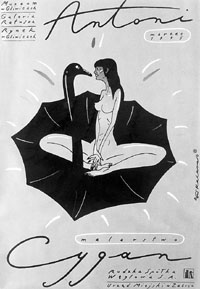Polish Institute stages prominent poster designer Roman Kalarus’ s display in Kyiv

The graphic poster has lost its place in the sun in the largest cities; it has to make do with being displayed in half lit galleries and museums. This is probably why Roman Kalarus’s display at the Central Artist’s House’s Maisternia [Workshop] Gallery in Kyiv greeted visitors with a special atmosphere, betraying a definitely archaic touch, reminding one of a cup spotted in an antique shop, so bewitchingly ancient, a collector’s dream, despite the fact that it had once been a perfectly commonplace, disposable kitchen utensil. Placards made by Kalarus are like special couturier products timed to a special occasion, such as the Postmodernism in the Cinema Festival, Cabaret musical, a jazz festival, or blues soiree. Roman Kalarus is one of the most brilliant figures in the modern Polish school of poster design. Art critic Iryna Veshtak aptly described him as a constant member of the Top World Poster Design League. In fact, his exposition is an eye-opener on the Polish school of poster design: frank and pure colors, clear lines, images “verging on the impossible” when erotic liberalism can be regarded as anything other than bare obscenity only by those bestowed with an exceptionally keen insight into the subtle creative approach tinged with an exquisite sense of humor. Despite such approaches that are very far from any fundamental religious dictates, Roman Kalarus is now working under contract, decorating a Roman Catholic Cathedral in Tyszy, not far from Katowice. The artist attended the Kyiv exhibit and willingly communicated with journalists, sharing his views on the arts.
The Day: There are a lot of posters displayed here, promoting jazz and blues concerts, elite movies, and plays. Does all this actually reflect your cultural preferences or is it just commissioned work?
R. K. : A good question and hard to answer. I belong to the sixties generation. We stepped into the big world along with blues melodies, so my posters stay in that jazz-blues range — at least I hope that they are. Of course, it was all commissioned work, but I am really very fond of jazz. I used to play the solo and bass guitars with a jazz group.
The Day: Does it make any difference working on a theme which is close to you as an artist or on one being remote from your personal creative preferences?
R. K. : You know, I had no commissions whatsoever as a student, so I did only jazz posters for my friends’ concerts. This was captivating at first, but then I realized I was repeating myself, so every time I could make a different poster, dealing with a different topic, was a real holiday, because on such occasions I could discover something new in my creative self. After all, every commission is a job that, in a way, destroys your creativity, exhausting your vital energy. I look forward to the day when I have enough money (perhaps never, but I am hopeful), so I can lock myself in my studio (which I still have to rent, I still can’t afford one) and paint something altogether different: beautiful women, models... I want to portray the male-female linkage, my own perception of man and his values in this world. For me, erotica, the sensuous world is the strongest creative impetus. This was perhaps why I enjoyed playing my bass with that jazz band; I must have always tried to convey the pulsation of the passions of my heart.
The Day: How close do you think a poster, as a creative design, is linked to its ultimate goal, advertising?
R. K. : Poster design requires mastery and subtlety; it is a person-to-person message. I hate advertising because of its rude intrusion into one’s delicate inner world. I have made several advertising posters in my time, but doing this on a regular basis requires a special kind of mentality, because advertising is mass- oriented; it does not address the individual.
The Day: Your posters teem in shockingly saturated colors, boasting a remarkable combination of rich violet, orange, red, azure, cobalt. You are now decorating a Roman Catholic cathedral. Is the palette you use there as strikingly colorful or more on the pastel, chaste side?
R. K. : More often than not, Polish artists, when offered such religious commissions, regard them as an easy and lucrative hackwork. When they called me and made their offer, I treated it as a creative challenge; I thought I could try a new approach. I wish to keep the whole project in my own style. For one thing, I do not understand why all those religious paintings should be kept in such traditionally amorphous, neutral colors? My colors might seem less that virtuous to some, but this is how I love it, and love comes from God.






